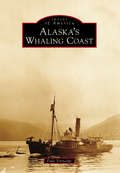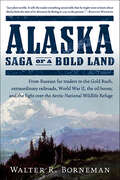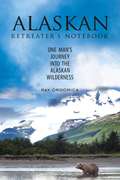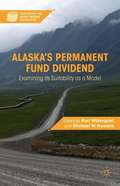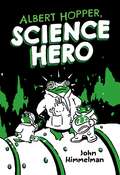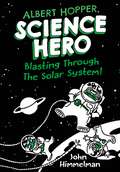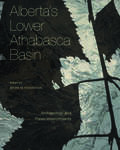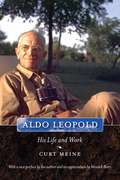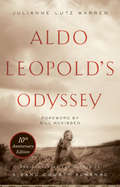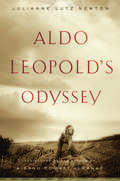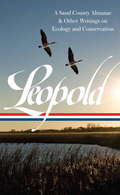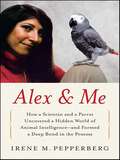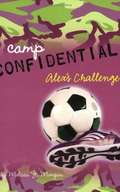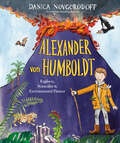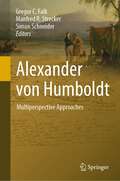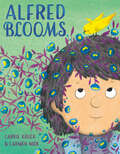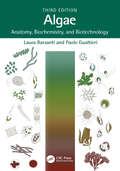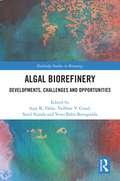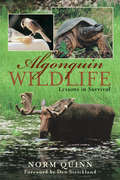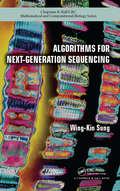- Table View
- List View
Alaska's Whaling Coast
by Dale VinnedgeIn 1850, commercial whaling ships entered the Bering Sea for the first time. There, they found the summer grounds of bowhead whales, as well as local Inuit people who had been whaling the Alaskan coast for 2,000 years. Within a few years, almost the entire Pacific fleet came north each June to find a path through the melting ice, and the Inuit way of whaling--in fact, their entire livelihood--would be forever changed. Baleen was worth nearly $5 a pound. But the new trading posts brought guns, alcohol, and disease. In 1905, a new type of whaling using modern steel whale-catchers and harpoon cannons appeared along the Alaskan coast. Yet the Inuit and Inupiat continue whaling today from approximately 15 small towns scattered along the Arctic Ocean and the Bering Strait. Whaling for these people is a life-or-death proposition in a land considered uninhabitable by many, for without the whale, whole villages probably could not survive as they have for centuries.
Alaska: Saga of a Bold Land
by Walter R. BornemanThis panoramic chronicle of Alaska captures the grandeur of its geography, history, and many larger-than-life personalities: “Just plain terrific” (Bradford Washburn).The history of Alaska is filled with stories of new land and new riches—and ever present are new people with competing views on how these valuable resources should be used. Here are the stories of Russians exploiting a fur empire; explorers checking rival advances; prospectors stampeding to the clarion call of “Gold!”; soldiers battling out a decisive chapter in WWII; oil wildcatters looking for a different kind of mineral wealth; and always at the core of these disputes is the question of how the land itself is to be used—and by whom.While some want Alaska to remain static, others are in the vanguard of change. Alaska: Saga of a Bold Land shows that there are no easy answers on either side of this perennial debate, and that Alaska will always be crossing the next frontier.
Alaskan Retreater's Notebook: One Man's Journey into the Alaskan Wilderness
by Ray OrdoricaIn the fall of 1978 Ray Ordorica packed everything he thought he would need into his Toyota LandCruiser and drove north to Alaska. He came to a land he had never seen, to find something he wasn't even sure existed: a wilderness cabin he could use for a year or more to live, think, relax, read, and write. Ordorica found his cabin, fixed it up, and, although it was just an un-insulated 12- by 16-foot one-room log structure, he spent three winters in it in relative comfort. Ordorica’s life in that cabin fulfilled a dream he had had for more than ten years. During his long winters in Alaska, it occurred to him that there must be many others who have put off an extended wilderness visit to out of ignorance or fear. They have as many questions about Alaska as he had before he arrived: How do you cope with 40 below? How do you get water? Is it totally dark in mid-winter? These questions and many more gave Ordorica the idea to write the Alaskan Retreater’s Notebook, an epic memoir about one man’s journey into the Alaskan wilderness. With his wisdom, you will learn how to live with the country, and not against it.
Alaska’s Permanent Fund Dividend
by Karl Widerquist Michael W. HowardContributors discuss the Alaska Permanent Fund (APF) and Permanent Fund Dividend (PFD) as a model both for resource policy and for social policy. This book explores whether other states, nations, or regions would benefit from an Alaskan-style dividend. The book also looks at possible ways that the model might be altered and improved.
Albatrosses (Nature's Children)
by Lorien KiteWhere do albatrosses live? Why do albatrosses fly in big loops? What do albatrosses eat? Find the answers to these questions, and learn much more about the physical characteristics, behavior, habitat, and lives of albatrosses. Other books in this series are available in this library.
Albert Hopper, Science Hero (Albert Hopper, Science Hero #1)
by John HimmelmanIn John Himmelman's early chapter book series, Albert Hopper is a frog—and a science hero! He seeks to explore the world and beyond, generating laughs and imparting STEM wisdom as he goes. Albert Hopper, Science Hero is on a mission: to travel to the center of the earth! With his wormlike ship Wiggles and the help of his niece and nephew, trusty Junior Science Heroes Polly and Tad, Hopper is ready to go where no frog has gone before.Thick layers of rock and rubble, tunnels of lava, and temperatures of 6,000 degrees stand between our heroes and their prize. Will they make it? Find out in this funny and informative adventure.
Albert Hopper, Science Hero: Blasting Through the Solar System! (Albert Hopper, Science Hero #2)
by John HimmelmanIn John Himmelman's early chapter book series, Albert Hopper is a frog—and a science hero! He seeks to explore the world and beyond, generating laughs and imparting STEM wisdom as he goes. Science Hero Albert Hopper and trusty Junior Science Heroes Polly and Tad are ready for their next adventure. This time, they're blasting through the solar system!As the heroes float through the sulphuric acid clouds of Venus, dodge the solar flares of the sun, and weather the space storms of Jupiter, their science smarts are put to the test. Anything can happen on this hilarious ride in Albert Hopper, Science Hero: Blasting Through the Solar System.
Albert the Albert
by Patricia Fuller KinseyFrom the book: If Albert could live under water, he might be a fish. And if he could fly, he just might be a butterfly-one with a very round stomach, that is. But Albert can't do either and he doesn't know what he is, except that he is something with two feet and that very round stomach. As Mrs. Bluebird points out, he can't be a bird: "No wings, you see." And he can't even hop, so he's definitely not a frog. Poor little Albert. Not one of the friendly animals of the forest can decide just what Albert is. They can only tell him what he isn't. But then, just when Albert and his friends are so tired they can scarcely walk another step, they go around a curve and there in a beautiful green meadow is the happy answer to all their questions. Patricia Kinsey's and artist Zena Bernstein's deep love of nature shines through story and illustrations with a sensitive, sure touch that makes ALBERT THE ALBERT a uniquely beautiful book. Picture descriptions are included.
Alberta's Lower Athabasca Basin: Archaeology and Palaeoenvironments
by John W. Ives Alwynne B. Beaudoin Angela M. Younie Brian M. Ronaghan Brian O. Reeves Duane G. Froese Elizabeth C. Robertson Eugene M. Gryba Gloria J. Fedirchuk Grant M. Clarke James A. Burns Janet Blakey Jennifer C. Tischer Laura Roskowski Luc Bouchet Murray Lobb Nancy Saxberg Raymond J. Le Blanc Robert R. Young Robin J. Woywitka Stephen A. Wolfe Thomas V. Lowell Timothy G. FisherOver the past two decades, the oil sands region of northeastern Alberta has been the site of unprecedented levels of development. Alberta's Lower Athabasca Basin tells a fascinating story of how a catastrophic ice age flood left behind a unique landscape in the Lower Athabasca Basin, one that made deposits of bitumen available for surface mining. Less well known is the discovery that this flood also produced an environment that supported perhaps the most intensive use of boreal forest resources by prehistoric Native people yet recognized in Canada. Studies undertaken to meet the conservation requirements of the Alberta Historical Resources Act have yielded a rich and varied record of prehistoric habitation and activity in the oil sands area. Evidence from between 9,500 and 5,000 years ago—the result of several major excavations—has confirmed extensive human use of the region’s resources, while important contextual information provided by key geological and palaeoenvironmental studies has deepened our understanding of how the region’s early inhabitants interacted with the landscape. Touching on various elements of this rich environmental and archaeological record, the contributors to this volume use the evidence gained through research and compliance studies to offer new insights into human and natural history. They also examine the challenges of managing this irreplaceable heritage resource in the face of ongoing development. Contributors: Alwynne Beaudoin, Angela Younie, Brian O.K. Reeves, Duane Froese, Elizabeth Roberston, Eugene Gryba, Gloria Fedirchuk, Grant Clarke, John W. Ives, Janet Blakey, Jennifer Tischer, Jim Burns, Laura Roskowski, Luc Bouchet, Murray Lobb, Nancy Saxberg, Raymond LeBlanc, Robert R. Young, Robin Woywitka, Thomas V. Lowell, and Timothy Fisher
Aldo Leopold
by Curt MeineThis biography of Aldo Leopold follows him from his childhood as a precocious naturalist to his profoundly influential role in the development of conservation and modern environmentalism in the United States. This edition includes a new preface by author Curt Meine and an appreciation by acclaimed Kentucky writer and farmer Wendell Berry.
Aldo Leopold's Odyssey, Tenth Anniversary Edition: Rediscovering the Author of A Sand County Almanac
by Julianne Lutz WarrenIn 2006, Julianne Lutz Warren(néeNewton) asked readers to rediscover one of history's most renowned conservationists. Aldo Leopold's Odyssey was hailed by The New York Times as a "biography of ideas," making "us feel the loss of what might have followed A Sand County Almanac by showing us in authoritative detail what led up to it. " Warren's astute narrative quickly became an essential part of the Leopold canon, introducing new readers to the father of wildlife ecology and offering a fresh perspective to even the most seasoned scholars. A decade later, as our very concept of wilderness is changing, Warren frames Leopold's work in the context of the Anthropocene. With a new preface and foreword by Bill McKibben, the book underscores the ever-growing importance of Leopold's ideas in an increasingly human-dominated landscape. Drawing on unpublished archives, Warren traces Leopold's quest to define and preserve land health. Leopold's journey took him from Iowa to Yale to the Southwest to Wisconsin, with fascinating stops along the way to probe the causes of early land settlement failures, contribute to the emerging science of ecology, and craft a new vision for land use. Leopold's life was dedicated to one fundamental dilemma: how can people live prosperously on the land and keep it healthy, too? For anyone compelled by this question, the Tenth Anniversary Edition of Aldo Leopold's Odyssey offers insight and inspiration.
Aldo Leopold's Odyssey: Rediscovering the Author of A Sand County Almanac
by Julianne Lutz NewtonA household icon of the environmental movement, Aldo Leopold (1887-1948) may be the most quoted conservationist in history. A Sand County Almanac has sold millions of copies and Leopold's writings are venerated for their perceptions about land and how people might live in concert with the whole community of life. But who is the man behind the words? How did he arrive at his profound and poetic insights, inspiring generations of environmentalists? Building on past scholarship and a fresh study of Leopold's unpublished archival materials, Julianne Lutz Newton retraces the intellectual journey generated by such passion and intelligence. Aldo Leopold's Odyssey illuminates his lifelong quest for answers to a fundamental issue: how can people live prosperously on the land and keep it healthy, too? Leopold's journey took him from Iowa to Yale to the Southwest to Wisconsin, with fascinating stops along the way to probe the causes of early land settlement failures, contribute to the emerging science of ecology, and craft a new vision for land use. More than a biography, this articulate volume is a guide to one man's intellectual growth, and an inspirational resource for anyone pondering the relationships between people and the land.
Aldo Leopold: A Sand County Almanac & Other Writings on Conservation and Ecology
by Aldo Leopold Curt MeineSince his death in 1948, Aldo Leopold has been increasingly recognized as one of the indispensable figures of American environmentalism. A pioneering forester, sportsman, wildlife manager, and ecologist, he was also a gifted writer whose farsighted land ethic is proving increasingly relevant in our own time. Now, Leopold's essential contributions to our literature--some hard-to-find or previously unpublished--are gathered in a single volume for the first time. Here is his classic A Sand County Almanac, hailed--with Thoreau's Walden and Carson's Silent Spring--as one of the main literary influences on the modern environmental movement. Published in 1949, it is still astonishing today: a vivid, firsthand, philosophical tour de force. Along with Sand County are more than fifty articles, essays, and lectures exploring the new complexities of ecological science and what we would now call environmental ethics. Leopold's sharp-eyed, often humorous journals are illustrated here for the first time with his original photographs, drawings, and maps. Also unique to this collection is a selection of over 100 letters, most of them never before published, tracing his personal and professional evolution and his efforts to foster in others the love and sense of responsibility he felt for the land.
Alebrijes: (Alebrijes Spanish Edition) (Cuentista)
by Donna Barba HigueraLa siguiente novela de Donna Barba Higuera, autora de The Last Cuentista (La última cuentista), galardonada con los premios Newbery y Pura Belpré ★ "Un clásico inmediato".—School Library Journal (destacado) ★ "Imaginación esplendorosa".—Foreword (destacado)★ "Un texto muy sentido que da señales de esperanza para la humanidad".—Kirkus (destacado)★ "Una aventura arriesgada… Asombrosa".—Booklist (destacado)★ "Estelar".—Publishers Weekly (destacado)★ "Inspiradora".—Bulletin of the Center for Children’s Books (destacado) ★ "Impresionante... Una novela distópica para jóvenes lectores que es intensamente épica y bella".—Shelf Awareness (destacado) He aquí la historia, tal como me la contó Leandro el Poderoso. Desde hace 400 años, la Tierra es un páramo estéril. Los pocos humanos que quedan luchan por sobrevivir en la cruel ciudad de Pocatel. Su otra opción es aventurarse solos en las tierras salvajes, que están plagadas de espíritus errantes y gudrones. No duran mucho.Leandro, un ladroncito de 13 años, y su hermana Gabi hacen lo que pueden para forjarse una vida en Pocatel. La ciudad no es amable con cascabeles como ellos, descendientes de quienes trabajaron en el valle de San Joaquín durante generaciones.Luego de que atrapan a Gabi robando la preciada fruta de la elite pocatelana, Leandro asume la responsabilidad del robo. Su exilio resulta ser mucho más de lo que él podría haber imaginado de un simple destierro: su conciencia es colocada en un antiguo dron y... a arreglárselas solo. Pero más allá de los muros de Pocatel hay otros alebrijes que, como Leandro, quieren un mundo mejor. También hay monstruos mutantes, piratas del páramo, un oasis oculto... y la verdad.Escrita por Donna Barba Higuera, autora de The Last Cuentista (La última cuentista), libro premiado con la Medalla Newbery y el premio Pura Belpré, llega esta nueva novela para sorprendernos y crear un nuevo mundo lleno de imaginación, espejo del nuestro.***The next stunning novel from Donna Barba Higuera, author of Newbery and Pura Belpré Award-winning The Last Cuentista ★ "An instant classic."—School Library Journal (starred) ★ "Imaginative splendor."— Foreword (starred) ★"Heartfelt… Signals hope for humanity."— Kirkus (starred) ★ "High-stakes adventure…Wondrous."— Booklist (starred) ★ "Stellar."— Publishers Weekly (starred) ★ "Uplifting."— Bulletin of the Center for Children’s Books (starred) ★ "Breathtaking... A ferociously epic and beautiful middle-grade dystopian novel."— Shelf Awareness (starred) This is the story as it was told to me by Leandro the Mighty. For 400 years, Earth has been a barren wasteland. The few humans that survive scrape together an existence in the cruel city of Pocatel – or go it alone in the wilderness beyond, filled with wandering spirits and wyrms. They don’t last long.13 year-old pickpocket Leandro and his sister Gabi do what they can to forge a life in Pocatel. The city does not take kindly to Cascabel like them – the descendants of those who worked the San Joaquin Valley for generations.When Gabi is caught stealing precious fruit from the Pocatelan elite, Leando takes the fall. But his exile proves more than he ever could have imagined -- far from a simple banishment, his consciousness is placed inside an ancient drone and left to fend on its own. But beyond the walls of Pocatel lie other alebrijes like Leandro who seek for a better world -- as well as mutant monsters, wasteland pirates, a hidden oasis, and the truth.From Donna Barba Higuera, Newbery and Pura Belpré Medal-winning author of The Last Cuentista, comes another novel to astonish us and create a whole new imaginative world, that holds a mirror to our own.
Alex & Me: How a Scientist and a Parrot Discovered a Hidden World of Animal Intelligence—and Formed a Deep Bond in the Process
by Irene M. PepperbergNew York Times BestsellerThe remarkable true story of an extraordinary relationship between psychologist Irene M. Pepperberg and Alex, an African Grey parrot who proved scientists and accepted wisdom wrong by demonstrating an astonishing ability to communicate and understand complex ideas. "You be good. I love you," were Alex's final words to his owner, research scientist Irene Pepperberg, before his premature death at age thirty-one on September 6, 2007. An African Grey parrot, Alex had a brain the size of a shelled walnut, yet he could add, sound out words, understand concepts like bigger, smaller, more, fewer, and none, and he disproved the widely accepted idea that birds possess no potential for language or anything remotely comparable to human intelligence.Alex & Me is the incredible story of an amazing, irascible parrot and his best friend who stayed together through thick and thin for thirty years—the astonishing, moving, and unforgettable story of a landmark scientific achievement and a beautiful relationship.
Alex's Challenge (Camp Confidential #4)
by Melissa J. MorganDuring the last weeks of summer camp, eleven-year-old Alex Kim has trouble hiding a secret from the other girls in bunk 3C while also trying to meet the high standards she sets for herself in sports, relationships, and other activities.
Alexander Wilson: The Scot Who Founded American Ornithology
by Edward H. Burtt William E. Davis Jr.Audubon was not the father of American ornithology. That honorific belongs to Alexander Wilson, whose encyclopedic American Ornithology established a distinctive approach that emphasized the observation of live birds. In the first full-length study to reproduce all of Wilson's unpublished drawings for the nine-volume Ornithology, Edward Burtt and William Davis illustrate Wilson's pioneering and, today, underappreciated achievement as the first ornithologist to describe the birds of the North American wilderness. Abandoning early ambitions to become a poet in the mold of his countryman Robert Burns, Wilson emigrated from Scotland to settle near Philadelphia, where the botanist William Bartram encouraged his proclivity for art and natural history. Wilson traveled 12,000 miles on foot, on horseback, in a rowboat, and by stage and ship, establishing a network of observers along the way. He wrote hundreds of accounts of indigenous birds, discovered many new species, and sketched the behavior and ecology of each species he encountered. Drawing on their expertise in both science and art, Burtt and Davis show how Wilson defied eighteenth-century conventions of biological illustration by striving for realistic depiction of birds in their native habitats. He drew them in poses meant to facilitate identification, making his work the model for modern field guides and an inspiration for Audubon, Spencer Fullerton Baird, and other naturalists who followed. On the bicentennial of his death, this beautifully illustrated volume is a fitting tribute to Alexander Wilson and his unique contributions to ornithology, ecology, and the study of animal behavior.
Alexander von Humboldt: Explorer, Naturalist & Environmental Pioneer
by Danica NovgorodoffBudding botanists, growing geologists, and early explorers will dive into this picture book biography about the father of ecology, Alexander von Humboldt. The captivating prose and art from a New York Times bestselling illustrator will spark a passion for discovery and conservation in the youngest readers.Whether sailing across the ocean, hiking through the jungle, or climbing the highest volcanic peaks, everywhere Alexander went, he observed the land, animals, and culture. And where others saw differences, Alexander spotted connections. Discover the incredible life of naturalist Alexander von Humboldt, whose explorations created the basis for modern ecology, whose travels made him one of the most famous scientists of his day, and whose curiosities have inspired generations of creative thinkers.
Alexander von Humboldt: Multiperspective Approaches
by Gregor C. Falk Manfred R. Strecker Simon SchneiderThis book aims to view and to understand Alexander von Humboldt from different perspectives and in varying disciplinary contexts. His contributions addressed numerous topics in the earth but also life sciences—spanning from geo-botany, climatology, paleontology, oceanography, mineralogy, resources, and hydrogeology to links between the environmental impact of humans, erosion, and climate change. From the very beginning, he paved the way for a modern, integrated earth system science approach to decipher, characterize, and model the different forcing factors and their feedback mechanisms. It becomes obvious that Humboldt’s holistic approach is far beyond simple description and empiric data collection. As documented and analyzed in the different texts of this volume, he combines observation and analysis with emotions and subjective perceptions in a very affectionate way. However, this publication does not intend to add another encyclopedic text compilation but to observe and critically analyze this unique personality´s relevance in a modern context, particularly in discussing environmental and social key issues in the twenty-first century.
Alfred Blooms
by Carrie KruckShy Alfred wants to befriend the girl whose yard is filled with other kids and flowers but he doesn't know how. When Alfred sees Lulu&’s magical yard filled with flowers and friends, he&’s sure that if he can cultivate a beautiful garden, friends will flock to join him. Alfred tries but nothing grows in his brown patch of dirt. Determined to make one last attempt, Alfred heads to the store to buy fresh flower seeds. As he hurries home, he sneezes—and the seeds fly everywhere! And this time they begin to grow wherever they land—in his pockets, in his hair, even in his ears! A very discouraged Alfred gets stuck in the mud. But the aroma of warm blueberry muffins coming from a nearby bakery reminds him of Lulu&’s favorite treat and, tucking the flowers under his hat, he heads there. Alfred shares muffins with Lulu and finds out that he doesn&’t need a garden; time spent together is the best way to make a friend. This charming friendship story is sensitive and delightful with just a touch of whimsy.
Algae: Anatomy, Biochemistry, and Biotechnology
by Laura Barsanti Paolo GualtieriA single-source reference on the biology of algae, the third edition of Algae: Anatomy, Biochemistry, and Biotechnology examines the most important taxa and structures for freshwater, marine, and terrestrial forms of algae. Its comprehensive coverage goes from algae's historical role through its taxonomy and ecology to its natural product possibilities. In this update, the authors have gathered a significant amount of new material, including: • more information on macroalgae • detailed description of biotic associations • updated description of biomass cultivation systems • coverage of different "omic" approaches and tools used in algal investigation • an expanded and updated algae utilization chapter The book's unifying theme is the important role of algae in the earth's self-regulating life support system and its function within restorative models of planetary health. It also discusses algae's biotechnological applications, including potential nutritional and pharmaceutical products. Written for students as well as researchers, teachers, and professionals in the field of phycology and applied phycology, this new full-color edition is both illuminating and inspiring.
Algal Biorefinery: Developments, Challenges and Opportunities (Routledge Studies in Bioenergy)
by Sonil Nanda Ajay K. Dalai Vaibhav V. Goud Venu Babu BorugaddaThis book enables readers to understand the theoretical aspects, key steps and scientific techniques with a detailed mechanism to produce biofuels from algae. Each chapter provides the latest developments and recent advancements starting from algal cultivation techniques to the production of value-added green fuels, chemicals and products with wide applications. The volume brings together a broad range of international and interdisciplinary experts, including chemical and biological engineers, biotechnologists, process engineers, environmentalists, pharmacists and nutritionists, to one platform to explore the beneficial aspects and challenges for an algal-based biorefinery. Chapters address cutting-edge issues surrounding algal cultivation, including genetic modification of algal strains, design and optimization of photobioreactors and open-pond systems, algal oil extraction techniques and algal-derived fuel products (biodiesel, bio-gasoline, jet fuels and bio-oil). Finally, the book considers the potential environmental impacts for establishing a sustainable algal biorefinery through lifecycle analysis, techno-economic assessment and supply chain management. This book will be an important resource for students, academics and professionals interested in algal cultivation, biofuels and agricultural engineering, and renewable energy and sustainable development more broadly.
Algonquin Wildlife: Lessons in Survival
by Norm Quinn Cassandra Ward Dan StricklandAlgonquin Wildlife: Lessons in Survival is a celebration of the vast array of wildlife studies ongoing in Ontario’s very first provincial park. Probably more research has been done in Algonquin than in any other protected landscape in the world. Norm Quinn, long-time Park Management Biologist in Algonquin, has been fortunate to know and to work with many of those dedicated and unique wildlife researchers who roam and probe the forests and lakes in search of Nature’s secrets. His knowledge, experience and sense of humour combine to transform technical biological studies, on moose, wolves, fish and other creatures of the wild, into entertaining and inviting stories without losing the significance of the research. This is also a book about Algonquin, Ontario’s flagship Park and one of the foremost canoe-tripping wilderness sites in the world. Through Algonquin Wildlife, you are invited to explore this relatively unknown but vital part of the Park’s heritage – a must for both seasoned and budding naturalists.
Algorithms for Next-Generation Sequencing (Chapman & Hall/CRC Computational Biology Series)
by Wing-Kin SungAdvances in sequencing technology have allowed scientists to study the human genome in greater depth and on a larger scale than ever before – as many as hundreds of millions of short reads in the course of a few days. But what are the best ways to deal with this flood of data? Algorithms for Next-Generation Sequencing is an invaluable tool for students and researchers in bioinformatics and computational biology, biologists seeking to process and manage the data generated by next-generation sequencing, and as a textbook or a self-study resource. In addition to offering an in-depth description of the algorithms for processing sequencing data, it also presents useful case studies describing the applications of this technology.
